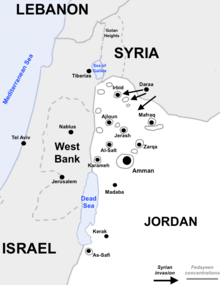This is an old revision of this page, as edited by Skitash (talk | contribs) at 19:54, 23 December 2024 (→Background). The present address (URL) is a permanent link to this revision, which may differ significantly from the current revision.
Revision as of 19:54, 23 December 2024 by Skitash (talk | contribs) (→Background)(diff) ← Previous revision | Latest revision (diff) | Newer revision → (diff) Short-lived invasion during Black September| Syrian invasion of Jordan | |||||||
|---|---|---|---|---|---|---|---|
| Part of Black September and the Arab Cold War | |||||||
 Map showing fedayeen concentrations in Jordan prior to September 1970, and the Syrian invasion | |||||||
| |||||||
| Belligerents | |||||||
|
|
| ||||||
| Commanders and leaders | |||||||
|
|
| ||||||
| Strength | |||||||
|
16,000 troops 170 T-55 tanks | 65,000–74,000 troops | ||||||
| Casualties and losses | |||||||
|
1,500 casualties 120 tanks |
112 casualties 16 tanks 1 armored car | ||||||
| Black September | |
|---|---|
The Syrian invasion of Jordan began on 18 September 1970 in support of the Palestine Liberation Organization (PLO) amid Black September in Jordan. Ba'athist Syria conducted a short-lived incursion toward Irbid in northern Jordan, before being forced to withdraw due to heavy casualties. Syria's supposed aim was to help the Palestinian fedayeen overthrow the Hashemite monarchy.
Background
On 17 September 1970, the Jordanian army surrounded several cities with a significant PLO presence and began targeting Palestinian fedayeen, viewing them as a threat to the Hashemite monarchy of King Hussein. Syria publicly threatened King Hussein, with Syrian president Nureddin al-Atassi stating that Syria would "spare no blood" to help the Palestinians. The Syrian foreign ministry warned that the "Syrian revolution cannot remain silent or idle about the massacres to which the Palestine revolution groups and the masses in Jordan are being exposed." The Syrian invasion expressed the ruling Syrian Arab Socialist Ba'ath Party's stance against "the reactionary regime" in Jordan and its desire to overthrow it. The Syrian Ba'ath Party adopted strongman Salah Jadid's policy of pushing for military intervention against Jordan on 17 September 1970.
The United States, seeing the Syrian incursion through the lens of Cold War politics, prepared to intervene on behalf of Jordan and block Soviet support for Syria.
Invasion

On 18 September 1970, a force from Syria with Palestine Liberation Army markings crossed the border into Jordan, reaching Irbid and declaring it a "liberated" city. The 40th Armored Brigade managed to block the Syrian advance after heavy fighting. A second and much larger Syrian incursion took place on the same day, consisting of two armored and one mechanized infantry brigade of the 5th Infantry Division, and around 300 tanks.
On 20 September 1970, Syria committed 16,000 troops and more than 170 T-55 tanks to invade Jordan, but declined to commit its air force. Jordanian forces managed to repel two Syrian armored offensives and inflicted heavy losses on a Syrian armored brigade. Syrian tanks crossed near Ramtha, advancing 5 miles past it, and slowly moved toward Irbid.
By the morning of 21 September, Syria had the battleground advantage, with almost 300 tanks and 60 artillery tubes near Ramtha and Irbid, some of which had already entered Irbid. Syrian forces later captured two key crossroads that served as gateways to the Jordanian capital, Amman.
By 22 September, however, the Syrian forces had been largely defeated as they attempted to breach Jordanian lines north of the Ajloun mountains. Syrian forces suffered due to Jordanian airstrikes, logistic shortfalls, and mechanical breakdowns. By midday, approximately 50 of 200 Syrian tanks became inoperable. Syrian forces began withdrawing from Jordan on the night of 22–23 September 1970.
Casualties
Although Jordan claimed to have destroyed 70 to 75 Syrian tanks, the final losses amounted up to 135 tanks and 1,500 casualties. Israel estimated that Syria had lost 120 tanks, including 60 to 90 destroyed by Jordanian forces, and the rest due to mechanical breakdowns. Jordan, on the other hand, only lost 16 tanks, an armored car, and sustained 112 casualties.
References
- ^ A. Mobley, Richard (2009). "Syria's 1970 invasion of Jordan" (PDF). U.S. Joint Military Contributions to Countering.
- Ryan, Curtis R. (2006). "The Odd Couple: Ending the Jordanian-Syrian "Cold War"". Middle East Journal. 60 (1): 33–56. ISSN 0026-3141.
- "Behind the Syrian Invasion". Economic and Political Weekly. 11 (30): 1107–1112. 1976. ISSN 0012-9976.
- ^ Shlaim, Avi (2009-10-06). Lion of Jordan: The Life of King Hussein in War and Peace. Knopf Doubleday Publishing Group. p. 326. ISBN 978-1-4000-7828-8.
- Shemesh, Moshe (2012-11-12). The Palestinian Entity 1959-1974: Arab Politics and the PLO. Routledge. p. 144. ISBN 978-1-136-28512-7.
- ^ A. Mobley, Richard (2009). "Syria's 1970 invasion of Jordan" (PDF). U.S. Joint Military Contributions to Countering.